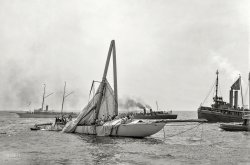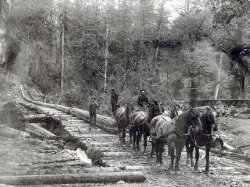
MAY CONTAIN NUTS

Search Shorpy
SHORPY ART

Framed or unframed, desk size to sofa size, printed by us in Arizona and Alabama since 2007. Explore now.
Join and Share
Ad-Free Shorpy
Shorpy is funded by you. Patreon contributors get an ad-free experience.
Learn more.

Recent comments
- A Beautiful Moment
- Such joy
- Bethune-Cookman University today...
- Yellow sky at morning
- Side Winder
- Air Quality?
- Sojourner Truth riot
- None were so blind(ed)
- The less famous sister
- Good ol' days?
- Rise and Fall
- Goo Goo Ga Joob
- Ticket Retention
- Not the only one
- Vagaries of War
- Killed by Amtrak
- Back to the Future
- Wanted --
- If you can't stand the light
- Centralized Traffic Control, I believe
- What's really happening
- Heckuva remote control!
- Sometimes — Things Go Bump!
- I SEE THE LIGHT
- Union Switch and Signal Company
- Get That Light Out Of My Eyes
- Eggs. Eggs. Eggs. The Egg Man is Here!
- Foreboding caption
- Famous Hollywood faces
- Not just S&P
Member Photos
The Shorpy
Print Emporium
Print Emporium
Search Shorpy
Search results -- 30 results per page
- Seagram: 1957
- ... by Pietro Belluschi in the Equitable Building in Portland, Oregon (1944-1947). The idea for the metal and glass curtain wall is generally ... Posted by Dave - 07/31/2012 - 6:35pm -
![Seagram: 1957 New York. January 23, 1957. "Seagram Building, Park Avenue. Oblique view from northwest." Large-format negative by Gottscho-Schleisner. View full size.
Bright Lights, Big CityAs a contractor in NY I have spent many days in this building and even though most people would pass it by and consider it in the same era as multiple other NYC buildings the mechanical infrastructure was decidedly from a past time. On another note the mostly underrated original GE building with its Deco crown is visible to the Seagram's right also a few blocks down is the Waldorf. Of interest to me at least the very Deco park ave light poles are still up with the original mercury vapor luminaires, also the last of the "greenies" two-light cast iron traffic poles are still in the median. I work for one of the companies that maintain and install NYC traffic and street lights.
Watershed Building1st "curtain wall" constructed building in US? World?
[The first curtain-wall building in New York was 1952's Lever House. Earlier examples elsewhere in the U.S. go back to the turn of the century. - Dave]
Four Seasons restaurant is in the 51st Street side of the building. If you keep walking east on 51st and get to Lexington Avenue, that is where the famous photo of Marilyn Monroe with her dress blown up was taken. Manhattan -- something happened almost everywhere.
Manhattan Tic-Tac-ToeWhat's with the markings on the windows of the three buildings at left? At first I thought all the X's were an indication the buildings were marked for demolition but some of the smaller windows have a pattern of X's and O's. Anyone know the significance?
+53Below is the same view, south from 53rd Street, taken in April of 2010.
Thoroughly ModernThe Seagram Building is a remarkable piece of architecture in its own right, but it also served as the turning point for several architects (including Philip Johnson) and was a prototype for many of Mies van der Rohe's building in the 1960s and '70s. Chicago, Montreal and Toronto all have Seagram Building "clones."
Xs on WindowsAn "X" pattern of tape (masking or duct) is often placed on window panes to reduce the possibility of the glass shattering when being removed. In this case, possibly it was done because of vibration caused by the construction of the Seagram Building? And the one on the far left, fancifully turning the small windows into tic-tac-toe games as a sly reference to that procedure?
World's most overrated buildingYes, it has better proportions and better materials than most modernist office towers, but that's like saying a particularly nice coat of fur makes one rat more attractive than other rats. At the end of the day, it's still a rat.
It's cold and dehumanizing, removed from street life by an unused plaza and windows that cannot open. The ceilings are low. The fluorescent lights are oppressive. The orange tinted windows make everyone inside look jaundiced.
The perpetual praise it gets from architects and critics — it routinely ranks among the ten most celebrated buildings of the past century — shows how barren those professions still are and why we are utterly incapable of building new environments that regular people love as much as those that predate WWI.
[I've visited the Seagram Building and the Four Seasons restaurant a number of times. They still count among the higher attainments of American civilization. - Dave]
The liquor motto:"Booze Builds"
"Curtain Wall" BuildingsThe term "curtain wall building" is misleading, because the curtain wall was developed hand in hand with the structural innovation called the "skeleton frame" - which was developed in Chicago in the 1880s. Early skyscrapers had curtain walls made of brick, stone, and terra cotta; these curtain walls were not self-supporting but rather "hung" from the skeleton frame (usually iron, steel, or later reinforced concrete). The first skeleton frame building in New York was the Tower Building at 50 Broadway (Bradford Gilbert, architect, built 1888-1889, demolished 1914); this was exceptional because skeleton frame construction was not permitted by the New York City Building Code until 1892. The use of metal and glass for curtain walls was introduced by Pietro Belluschi in the Equitable Building in Portland, Oregon (1944-1947). The idea for the metal and glass curtain wall is generally attributed to Ludwig Mies van der Rohe. He designed theoretical projects for such buildings in Berlin in 1921 and 1922, but his first built examples were two apartment buildings in Chicago at 860 & 880 North Lake Shore Drive (built 1948-1951). In the Seagram Building, Mies adapted his design for 860 & 880, with one major change: the mullions on the facade are not steel, but bronze.
(The Gallery, Gottscho-Schleisner, NYC)](https://www.shorpy.com/files/images/5a24904u.thumbnail.jpg)
- Time and Tide: 1941
- September 1941. "By the Pacific Ocean. Seaside, Oregon." Medium format acetate negative by Russell Lee for the Farm Security ... Posted by Dave - 03/18/2022 - 9:55pm -
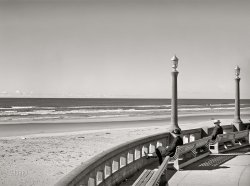
- Fishing Hole: 1941
- May 1941. Malheur County, Oregon. "Glory hole of the Owyhee Reservoir. Water for the Vale-Owyhee ... Posted by Dave - 07/12/2021 - 12:32pm -
![Fishing Hole: 1941 May 1941. Malheur County, Oregon. "Glory hole of the Owyhee Reservoir. Water for the Vale-Owyhee irrigation project is impounded here." Medium format acetate negative by Russell Lee for the Farm Security Administration. View full size.
Certain Death?It would seem like being sucked down that hole would be certain death. Why is there no safety fence around the hole that would prevent a person or animal that had been unfortunate enough to be pulled into its swirling vortex?
The only warning sign I can see is a 'No Fishing' sign - which obviously is being ignored.
[Not so. Read the rest of the sign. - Dave]
No gluts, no gloryIf there isn't enough water in the spring runoff, they aren't able to use the Glory Hole Spillway (err, Morning Glory Ring Gate). After some dry years, they had enough water to use the gate in 2017, and for several years after. Recently, they deliberately drew down water levels so they could do maintenance on the gate.
OK, Let's Be ClearI would not want to fall in there!
The hole? It's still there. But then, where else would it go?
A Descent into the MaelstromThat hole in the water brings to mind the 1845 story by Edgar Allan Poe. Who knows what’s inside this Owyhee Reservoir hole? Possibly not what the storyteller in Poe’s tale found: "Never shall I forget the sensations of awe, horror, and admiration with which I gazed about me. The boat appeared to be hanging, as if by magic, midway down, upon the interior surface of a funnel vast in circumference, prodigious in depth, and whose perfectly smooth sides might have been mistaken for ebony, but for the bewildering rapidity with which they spun around, and for the gleaming and ghastly radiance they shot forth, as the rays of the full moon, from that circular rift amid the clouds which I have already described, streamed in a flood of golden glory along the black walls, and far away down into the inmost recesses of the abyss.”
Glory holeI saw a picture of the gloryhole at flood stage and water was pouring down it at an alarming rate. The picture was captioned “Someone divided by zero.”
A decent descent"Glory hole" -- you don't want to know what information you get if you "google" it!
Look here for a decent description of the descent.
(The Gallery, Agriculture, Industry & Public Works, Kids, Russell Lee)](https://www.shorpy.com/files/images/SHORPY-8c01018a.thumbnail.jpg)
- Shooting the Bull: 1913
- ... According to stockyard authorities, about 200 short-horn Oregon steers were unloaded yesterday morning, consigned to various butchers in ... Posted by Dave - 09/11/2011 - 10:16am -
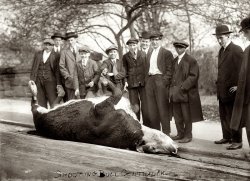
- Hotel St. Charles: 1910
- ... is quite a bit of that style work out here in Portland, Oregon, especially on the older buildings built around 1900.
Are we ... Posted by Dave - 08/08/2012 - 2:50pm -
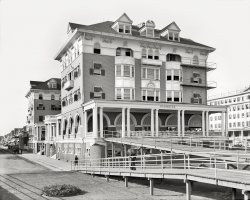
- Wedding Day Daguerreotype: 1854
- ... Van Buren Jones on their wedding day in Marion County, Oregon, Oct. 29, 1854. They met and fell in love while crossing on the Oregon Trail in 1852 when he was 21 and she was 14. He was traveling alone, ... Posted by DBerry53 - 10/02/2015 - 8:35pm -
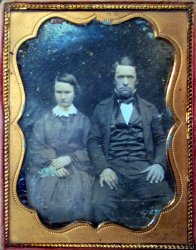
- The Busy Kitchen: 1941
- ... years. Vale-Owyhee irrigation project, Malheur County, Oregon." Medium format negative by Russell Lee for the Farm Security ... Posted by Dave - 02/16/2019 - 1:34pm -
![The Busy Kitchen: 1941 May 1941. "Mrs. E.E. Botner, wife of FSA rehabilitation borrower, wringing laundry in electric wringer. This family has been on the project for about five years. Vale-Owyhee irrigation project, Malheur County, Oregon." Medium format negative by Russell Lee for the Farm Security Administration. View full size.
Wringer Washer PrimerSeveral years ago a friend of mine in Vancouver, B.C., bought a Maytag wringer washer that had never been used in forty years since it was new. We fired it up, and I made a YouTube video of its first operation. For those unfamiliar with wringer washers, this should help out. I used machines like this decades ago. In Canada, wringer machines outsold automatics until 1968. In the U.S.A. this point was reached in 1951. One reason for this was that an automatic in Canada cost triple the price of a wringer washer. I have a 1944 Beatty wringer washer I still use from time to time.
Dangerous wringersBack in the '50s my cousin got caught in one of those wringers. It chewed most of the skin off the bottom of his arm before my aunt could get it turned off. He had to wear a brace for several months to hold his arm out so the skin would heal properly. They were afraid his arm would be stuck to his side if they hadn't.
Kid memoryRGraham's photo brought back a long lost memory that made me smile. My mom had a mangle and I loved lying on the floor under it in the kitchen as the warm ironed sheets came off the roller on me as we listened to radio programs like "Life With Luigi" or Henry Aldrich.
What's not to loveElectric stove and washing machine, running water -- all the modern conveniences in 1941. Reminds me of the Uriah Heep tune EZ Livin'.
The rest of the story ...Out of curiosity, I looked up Census Bureau records based on her husband's name, and it is likely Mrs. E.E. (Lula) Botner was about 45 when this photo was taken. It appears she died in 1970 in Idaho. I expect she was probably plumb worn-out!
Life was tough for us ladies back then.
Thet weren't called mangles for nothingLotta fingers (and occasionally other parts of the human anatomy) accidentally passed between those rollers.
Watch that hair!As Ozinor noted, a lot of accidents with those wringers. I can recall hearing stories of women who lost part of their scalps when their long hair got caught in the wringer.
Wringers vs ManglesThe device on the washing machine for squeezing water out of wet laundry is a wringer. A "mangle" was a more common (and descriptive) name for an ironing machine that had two long heated rollers used for ironing flat items. Not many of these were sold because they took up a lot of space, were pricey, and--yes--because they easily mangled the hands of unwary users.
ManglerAlthough I'm sure the wringer was more than capable of sucking in some body parts, the image below is what most people called a "mangler". It was a machine that ironed clothes and most any other items needing ironing. It took some practice to do it correctly.
[That's a mangle, not a "mangler." - Dave]
I guess they are both "mangles". https://en.wikipedia.org/wiki/Mangle_(machine) We still called it the mangler.
Here's a youtube instructional video if you're so inclined to try one out. https://www.youtube.com/watch?v=WkgN2YpeKu0
Power cordI suppose that the electrical cord running straight up near her head is connected to the light socket, and powers the machine. They didn't have convenience outlets back then, in the older houses.
(The Gallery, Kitchens etc., Rural America, Russell Lee)](https://www.shorpy.com/files/images/SHORPY-8c01154a.thumbnail.jpg)
- The Hair Brothers at Crater Lake: 1975
- 1975, Crater Lake, Oregon. A friend, my brother and me, captured during the golden hour. I shot ... Posted by tterrace - 02/10/2018 - 9:42pm -
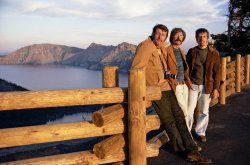
- Washington Flyer: 1925
- ... derision, at least until Dick Fosbury of the University of Oregon won the Olympic gold medal. By the 1980 Olympics, the straddle was ... Posted by Dave - 08/31/2012 - 8:20pm -
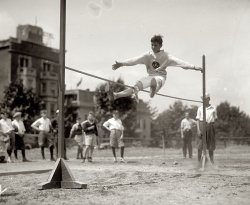
- Old-School Barbecue: Planked Shad
- ... more flavorful and less bony.
Smoked Fish Depoe Bay Oregon has a BBQ like this one every year. September I believe. It's called ... Posted by Dave - 07/29/2012 - 7:42pm -
![Old-School Barbecue: Planked Shad Barbecue at Marshall Hall, Maryland, in 1893. View full size. Photograph by William Cruikshank. Marshall Hall, an estate on the Potomac opposite Mount Vernon, had a boat landing and was popular with day-trippers from Washington.
Old-School Barbecue: 1893What you have there is a good old-fashioned Maryland Eastern Shore "shad planking."
Shad are cooked as shown, smoked on standing oak boards and basted with the cook's special sauce, served with "beaten biscuits." There are two schools of thought about the menu: some think it exquisite, others think it inexcusable.
The whole ritual sparked an annual Virginia political picnic every April, where pols and their supporters gather to plank some shad and speechify.
[Thanks muchly. I knew someone out there would enlighten me. - Dave]
Followup: Old-School BarbecueThis started down in Texas in the late 1800's. But I noticed those silly Yankees, unlike us Texans, threw the shad aside and ate the planks, which were more flavorful and less bony.
Smoked FishDepoe Bay Oregon has a BBQ like this one every year. September I believe. It's called the Salmon Bake and has been going on for 60 years or so. BBQ pit looks the same though.
The Acme of Success
American Food and Game Fishes
David Starr Jordan, Barton Warren Evermann
1908
...
The shad is very prolific. Single fish have been known to yield from 60,000 to 156,000 eggs, though the usual number does not exceed 30,000. The eggs are very small, semi-buoyant, and usually require 6 to 10 days for hatching, the time varying with the temperature of the water.
Unlike most other fishes shad roe is considered a great delicacy when fried; and ever since the days of George Washington and John Marshall "planked shad" has been regarded as the acme of success in the preparation of a delicious fish for the table. And a planked shad dinner at Marshall Hall, near Mount Vernon, is quite sure to constitute a feature in the spring programme of many Washington societies.
...
(The Gallery, William Cruikshank)](https://www.shorpy.com/files/images/03334u.thumbnail.jpg)
- City Sidewalks: 1940
- ... the craziness around us these days.
Mike J.
Albany, Oregon
Odd isn't it... ...this oasis of normalcy among the gritty ... Posted by Dave - 12/30/2007 - 10:47pm -
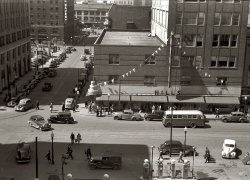
- The Simple Life: 1939
- ... of Soper kitchen. Willow Creek area, Malheur County, Oregon." View full size. Nitrate negative by Dorothea Lange.
Sweeping ... Posted by Dave - 11/07/2008 - 10:14pm -
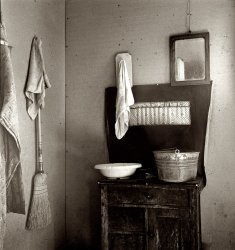
- Crate & Barrel: 1936
- ... still live. After the harvest, they moved south to Oregon, where my father pulled carrots and my mother found work as a ... 1914 (98 years ago today) issue of the Bandon Recorder, in Oregon.
Zerolene The sad part of this picture is that the Zerolene ... Posted by Dave - 08/06/2012 - 4:47am -
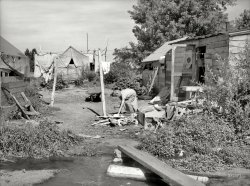
- Forest Camp: 1950s
- ... Bliss bunch was also camping along the Northern California/Oregon coast.
Nomad camping I took several trips up in that area as a ... Posted by Tony W. - 02/02/2012 - 12:19pm -
![Forest Camp: 1950s Here's the Blissmobile with the portable kitchen attached. This looks like it could be Yosemite again, in the mid-fifties. 35mm color slide. View full size.
Russian River areaFrom the looks of the redwood trees, I'm saying Russian River, or anywhere on the north coast. I remember how families would tie ropes between the trees and hang large tarps over them to create very nice campsites. Some would stay all summer, and others a couple of weeks. I can just smell those dried redwood leaves lying on the ground baking in the sun.
Cool little teardrop trailer.
Action ComicsSuperman and Dick Tracy go camping.
Do it in a Buick1947 Buick, I believe. Maybe 1948.
[1948-49 chrome trim through the door handles. More here. This was the Special body used from 1942 through 1949. - Dave]
Look, an off-road Buick. Here's another.I was 17. Mid-50s, rainy roadway, slick street car tracks on Sixth Avenue in Altoona, Pa. ("Gateway to The Rest of the World"). I manage to slide my Dad's 1942 Buick Century up onto the sidewalk and hit the convent of Sacred Heart Parish (my grade school alma mater). A woman appears. 'Oh, my gosh! Did you wreck?" The last couple of bricks were landing on my hood. "I’m not sure I'm done yet.” That was Monday. On Saturday I smashed up my mother’s Willys station wagon.
Camping BlissI think rgraham is on to something; those look to me like coast redwood leaves, not giant sequoia. We know that the Bliss bunch was also camping along the Northern California/Oregon coast.
Nomad campingI took several trips up in that area as a kid. Some of my best memories are when we loaded up the 1959 Chevy Nomad wagon (see below) and headed up north from SoCal. We camped in places like Clear Lake, MacArthur-Burney Falls, Lake Shasta, Mt. Lassen, you name it.
Dad took care of the logistics, Mom took care of the cooking. Little old me had his comic books and drawing pad to while away the hours in the car.
Thanks, TonyW for posting.
(ShorpyBlog, Member Gallery, Tonypix, Travel & Vacation)](https://www.shorpy.com/files/images/campsite2.thumbnail.jpg)
- Mr. Beans: 1939
- August 1939. "Oregon. Unemployed lumber worker goes with his wife to the bean harvest. Note ... Posted by Dave - 11/01/2013 - 10:00pm -
![Mr. Beans: 1939 August 1939. "Oregon. Unemployed lumber worker goes with his wife to the bean harvest. Note Social Security number tattooed on his arm." The jolly fellow seen here a few years back. Photo by Dorothea Lange. View full size.
HemingwayesqueThis man reminds me of writer Ernest Hemingway when he was a young man.
The similarity is even more pronounced in the other photo linked to in the above caption. In that other photo, we see a very attractive lady in the background who was this man's wife. These two people have a look of refinement about them that makes one wonder if they were formerly well-to-do and then fell on hard times.
At any rate, the photos are very interesting. Many thanks for posting.
[He was no doubt a member of the Tattoo Aristocracy. A Hello to Arms. - Dave]
I am what I amand that's all that I am, I'm Popeye the Sailor Man.
Two pictures are better than oneI recognized this guy instantly, but where I thought he was nice looking in the first one, this one isn't that impressive, IMO!
I have always believed that one picture of a person can be fairly misleading. Two pictures provide much more information!
(The Gallery, Dorothea Lange, Handsome Rakes)](https://www.shorpy.com/files/images/SHORPY_8b34512a.thumbnail.jpg)
- Up for the Fourth: 1941
- ... July 1941. Girls at the Fourth of July carnival in Vale, Oregon. View full size. 35mm nitrate negative by Russell Lee for the Farm ... Posted by Dave - 09/09/2011 - 11:25am -
![Up for the Fourth: 1941 July 1941. Girls at the Fourth of July carnival in Vale, Oregon. View full size. 35mm nitrate negative by Russell Lee for the Farm Security Administration.
Carnival CanesHere's what an Antiques Roadshow appraiser says about them:
http://www.pbs.org/wgbh/roadshow/archive/200502A30.html
Carnival Cane?It looks like the dark-haired woman is holding some wooden carnival canes. I have one with a ceramic dog head at the top that looks similar to the one she's holding, but it's hard to see the details. They just don't make carnival prizes like they used to!
Carnival Cane!I have not seen one of those carnival-prize canes in over forty years. Oh, how we wanted to win them; oh, how useless they were.
[I wondered what that was! Below, a closeup of the prizes. - Dave]
That's IT!That's my bulldog carnival cane, right there. It looks like a cat from the back but it's a dog. Now I know how old mine is!
Carnie CanesWhat was their point? To grab the brass ring?
Kewpie DollIn her other hand she appears to be holding a kewpie doll sort of like this 1930'2 carnival prize on
http://tinyurl.com/2y2284
(The Gallery, July 4, Russell Lee, Small Towns, Sports)](https://www.shorpy.com/files/images/8a30184u_0.thumbnail.jpg)
- 5½ Men: 1939
- ... song -- the rest of the lyrics are NSFW. He worked the Oregon woods as a "whistle punk" at age 13. A stationary steam engine was at ... Posted by Dave - 08/12/2014 - 3:55am -
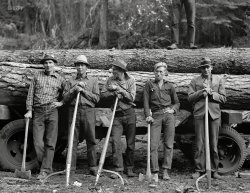
- Big Variety: 1941
- July 1941. "Main street of Vale, Oregon, on the Fourth of July. Vale is one of the shopping centers for farmers ... Posted by Dave - 04/08/2021 - 5:08pm -
![Big Variety: 1941 July 1941. "Main street of Vale, Oregon, on the Fourth of July. Vale is one of the shopping centers for farmers who live and work on the Vale-Owyhee irrigation project." Medium format acetate negative by Russell Lee for the Farm Security Administration. View full size.
LocationThis is actually one block west of Main Street, at the intersection of Court Street and A Street looking east down A Street toward the mountain slope.
[The principal thoroughfare of a town is the main street. Which may or may not be called Main Street. The main street of Vale is A Street. Don't even ask who's on First. - Dave]
However if Main Street is capitalized one can assume that that is the name of the street rather than just the "main street of the town".
[In our photo caption, it's not capitalized. - Dave]
Rough day at the Tavern?What happened to the awning in front of the Coca Cola soda fountain? Maybe the guy walking right in front of the car tried to swing from it after getting kicked out of the Town Tavern? Mr. Whitehat seems to be playing it safe by looking before crossing.
July 2015But probably not the Fourth of July, based upon the comparatively placid scene:
Color me!Boy howdy, this would be a great image to colorize! Somebody with more time and skills should take it on, even without any pretty girls in it!
De-EvolvementI look at street-scapes of the past and compared to most exact scenes of today all I can think of how devolved we have become.
The Main Streets used to look so vibrant with activity, signs, flags, stores, and well....life.
Today most places look like ghost towns with a lot of parked cars.
Honeymoon HotelMy folks spent their extended Honeymoon in the Vale Hotel just a couple of years before this photo was taken. They were married on New Years Day 1939 in Boise, and stayed in that hotel for two weeks or so while they waited for their permanent house to be available. They lived in Vale for 15 years.
(The Gallery, Cars, Trucks, Buses, July 4, Russell Lee, Small Towns)](https://www.shorpy.com/files/images/SHORPY-8c36614a.thumbnail.jpg)
- This Land Is Your Land: 1936
- ... Administration workers. Rimrock Camp. Madras, Oregon." Medium format negative by Arthur Rothstein. View full size.
Those boots denote they may have been loggers, being in Oregon it may be true.
The guy with the guitar Nicolas Cage with a ... Posted by Dave - 08/06/2012 - 1:24pm -
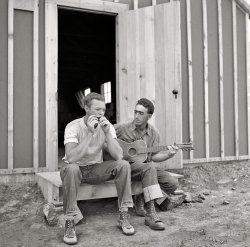
- Road Train: 1918
- ... roam the roads.
I have driven next to triple trailers in Oregon.
In Australia they even run quads.
Palm Tree and a Weeping Willow ... Posted by Dave - 06/10/2016 - 11:12am -
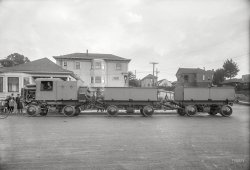
- Fair Maidens: 1942
- July 1942. "Klamath Falls, Oregon. Carnival of the circus." In line for the Tilt-A-Whirl. Photo by Russell ... Posted by Dave - 03/20/2016 - 8:48pm -

- Going Places: 1943
- ... or 4 years old, my mother and I took the bus from Eugene, Oregon, to Salem to see her brothers. At that time there was a "stewardess" on ... Posted by Dave - 05/14/2014 - 2:36pm -
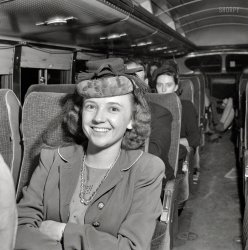
- Veteran Park: 1900
- ... park... Actually, "Mill Ends Park" in Portland Oregon is recorded in the Guinness Book of World Records as the Worlds Smallest ... Posted by Dave - 08/21/2012 - 6:31pm -
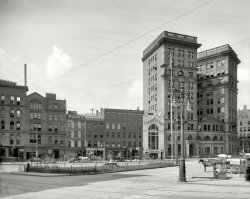
- Grandfather's team
- After he moved to Oregon in the early 1890s, my grandfather bred and trained teams of Belgians ... teams, hauling logs on a skid road near Clatskanie, Oregon, circa 1905. That's him seated at the rear, controlling the reins of the ... Posted by willc - 09/20/2011 - 12:57pm -
- One Nation Indivisible: 1941
- July 1941. "Citizens of Vale, Oregon take off their hats during the Pledge of Allegiance (radio program) on ... Posted by Dave - 01/24/2008 - 12:00am -
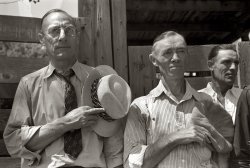
- The Old Ball Game: 1942
- ... like the first in history to be publicly displaying the Oregon "O." He's almost got it.
(The Gallery, Detroit Photos, John Vachon, ... Posted by Dave - 06/08/2011 - 1:37pm -
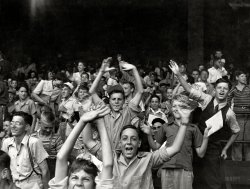
- Elmer and the Union Pacific
- ... like the eastern Columbia River Gorge, east of The Dalles, Oregon, out toward Rufus and Biggs Junction and possibly a little beyond ... Union Pacific tracks then and now are on the south, Oregon, side of the Columbia. The highway has changed since 1953, of course, ... Posted by notycoon22 - 05/21/2007 - 10:31pm -
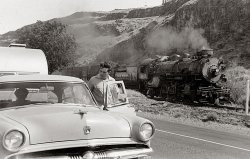
- Spud Cellar: 1939
- ... main street of potato town during harvest season. Merrill, Oregon. View full size. Photograph by Dorothea Lange.
"I like them ... Posted by Dave - 09/08/2011 - 2:17pm -
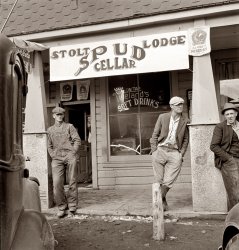
- Officer Pods: 1943
- ... on the farm here - they're all over the place in Eastern Oregon wheat country. It's easier to haul your wheat to the elevators now, so ... Posted by Dave - 03/31/2014 - 7:24am -
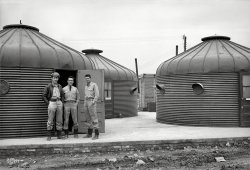
- Demasted: 1899
- ... the 1899 America's Cup and was replaced by a mast made of Oregon pine. This was a rare misjudgment by the great Nathanael Herreshoff, her ... Posted by Dave - 08/17/2016 - 3:54pm -
